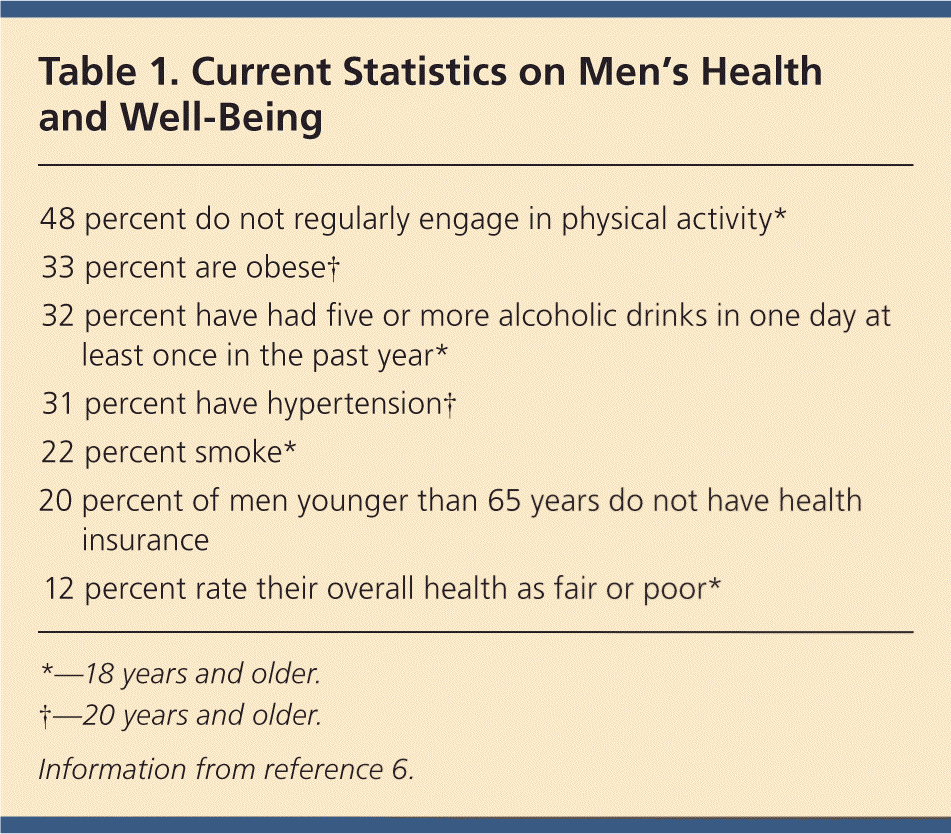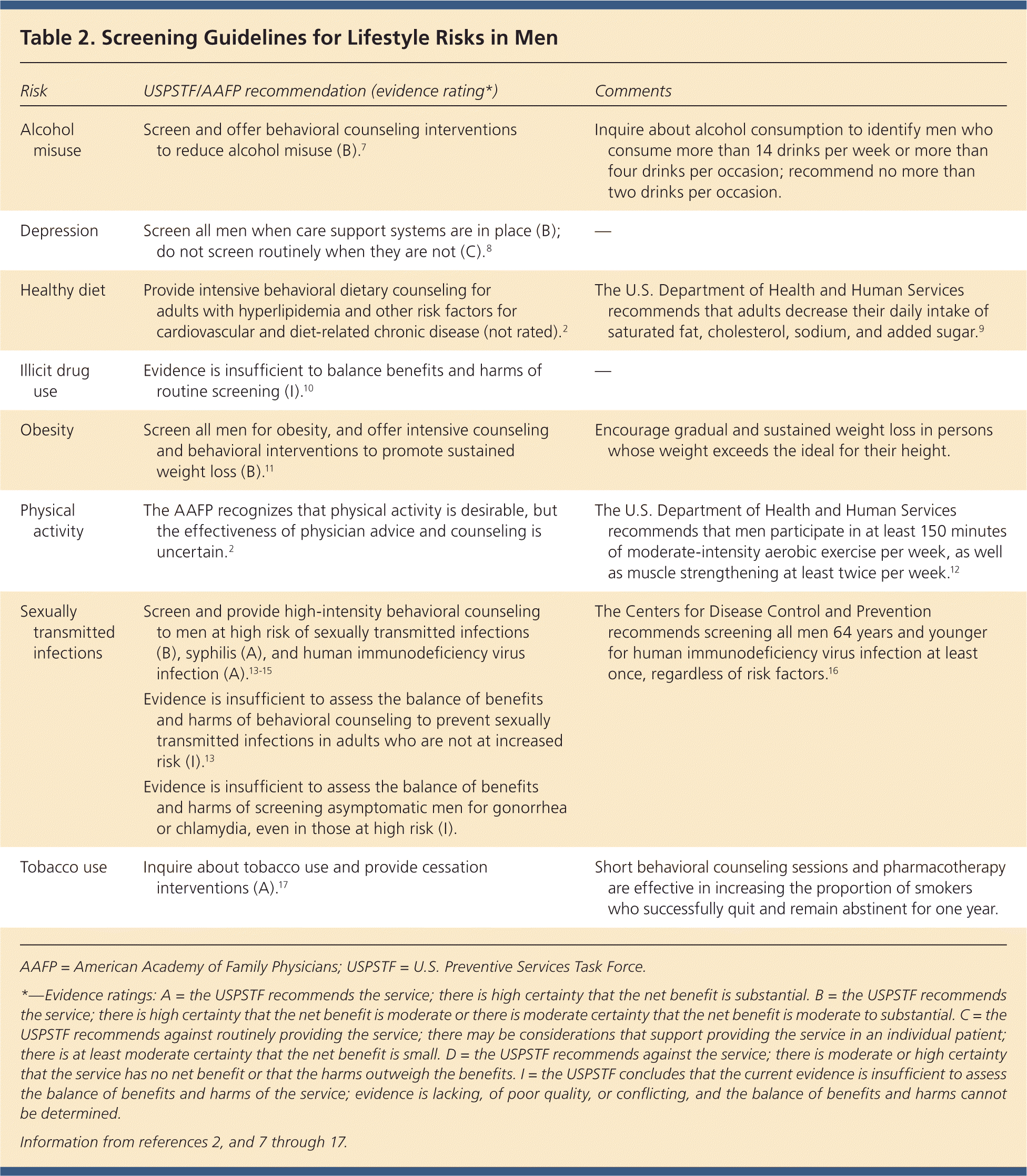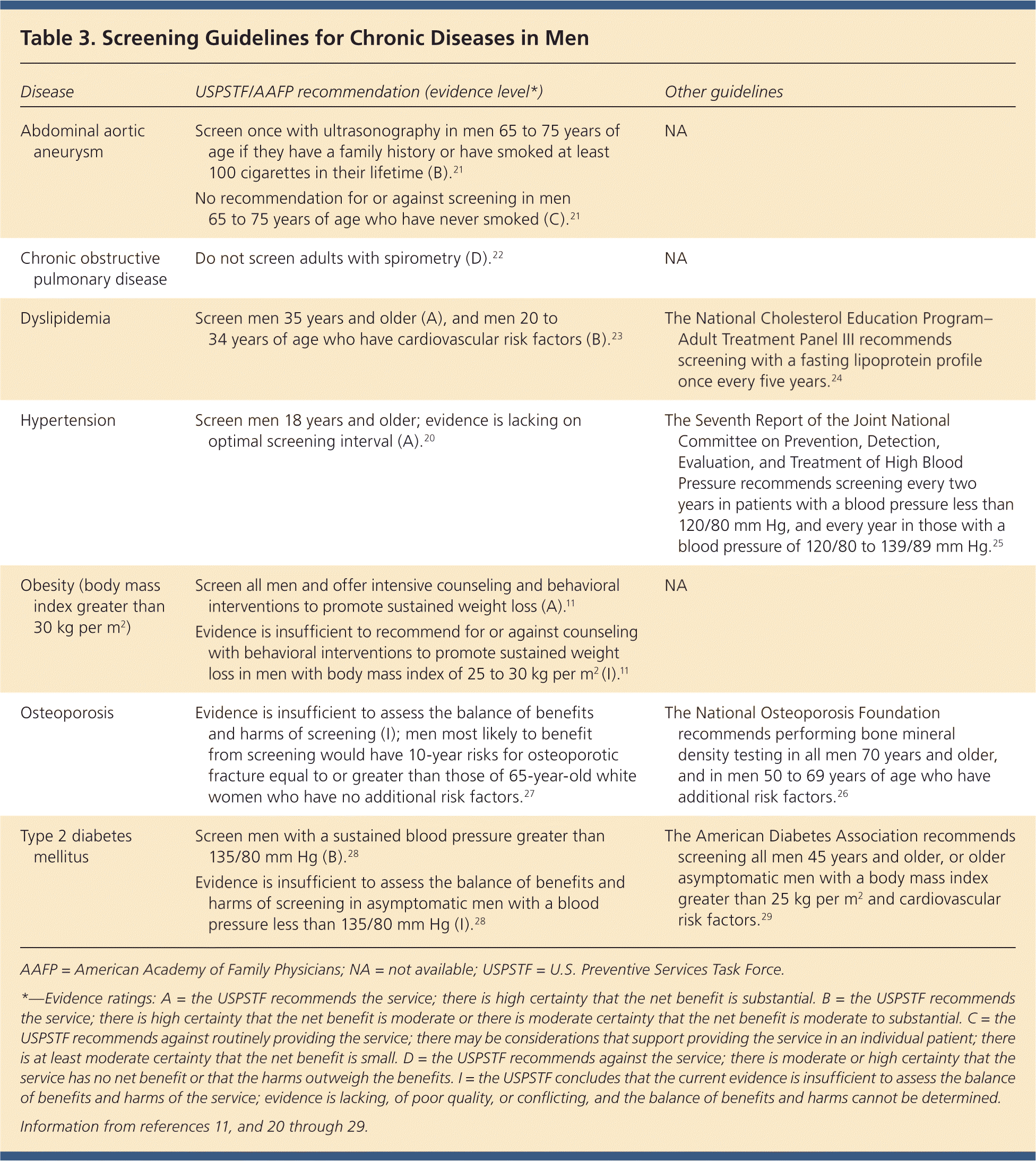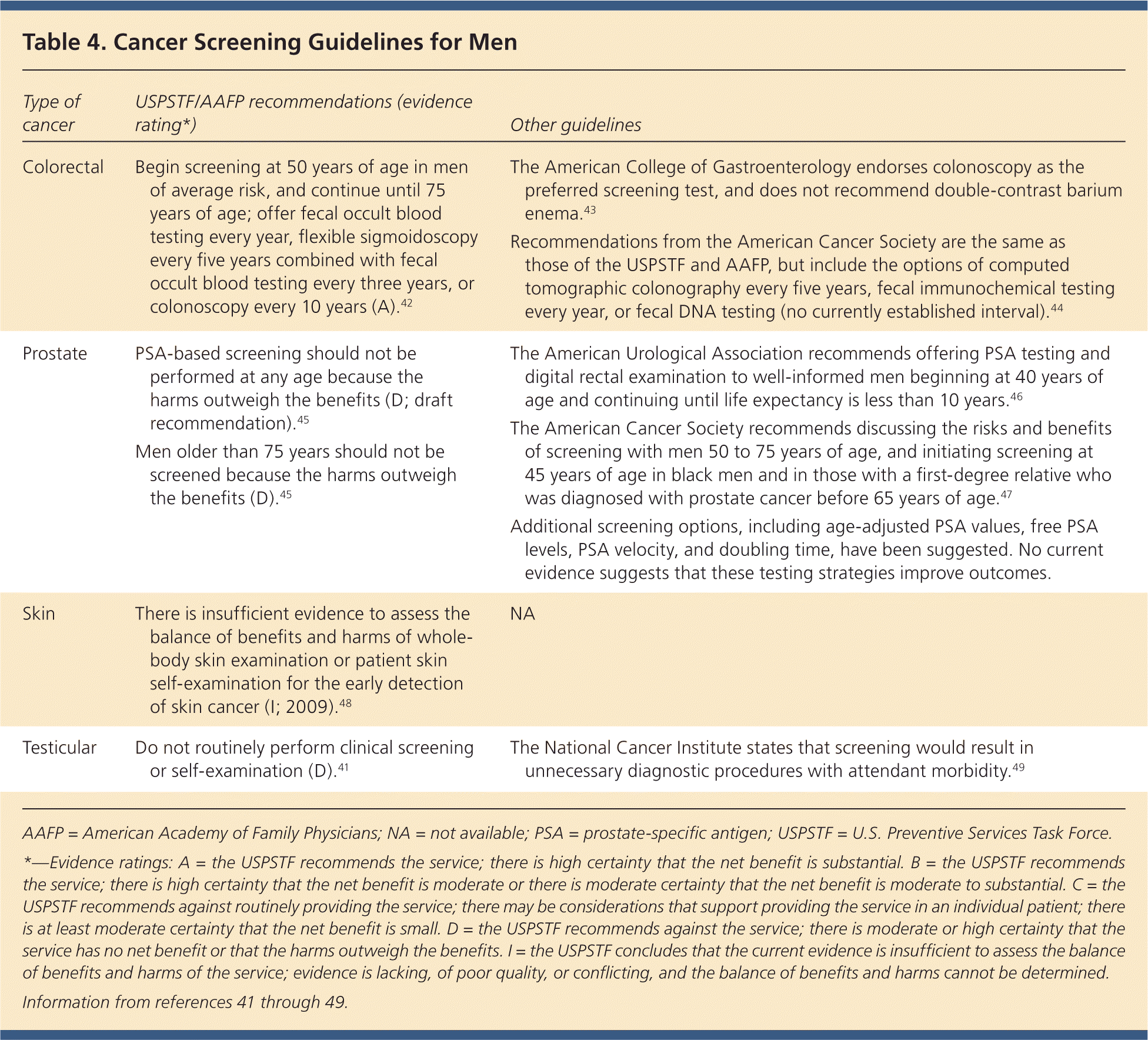
This is a corrected version of the article that appeared in print.
Am Fam Physician. 2012;85(10):964-971
A more recent article on adult well-male examinations is available.
See related editorial on page 956.
Related letter: Additional Screenings in the Adult Well Male Examination
Patient information: See related handout on men's health, written by the authors of this article.
Author disclosure: No relevant financial affiliations to disclose.
The adult well male examination should incorporate evidence-based guidance toward the promotion of optimal health and well-being, including screening tests shown to improve health outcomes. Nearly one-third of men report not having a primary care physician. The medical history should include substance use; risk factors for sexually transmitted infections; diet and exercise habits; and symptoms of depression. Physical examination should include blood pressure and body mass index screening. Men with sustained blood pressures greater than 135/80 mm Hg should be screened for diabetes mellitus. Lipid screening is warranted in all men 35 years and older, and in men 20 to 34 years of age who have cardiovascular risk factors. Ultrasound screening for abdominal aortic aneurysm should occur between 65 and 75 years of age in men who have ever smoked. There is insufficient evidence to recommend screening men for osteoporosis or skin cancer. The U.S. Preventive Services Task Force has provisionally recommended against prostate-specific antigen–based screening for prostate cancer because the harms of testing and overtreatment outweigh potential benefits. Screening for colorectal cancer should begin at 50 years of age in men of average risk and continue until at least 75 years of age. Screening should be performed by high-sensitivity fecal occult blood testing every year, flexible sigmoidoscopy every five years combined with fecal occult blood testing every three years, or colonoscopy every 10 years. [ corrected] The U.S. Preventive Services Task Force recommends against screening for testicular cancer and chronic obstructive pulmonary disease. Immunizations should be recommended according to guidelines from the Advisory Committee on Immunization Practices of the Centers for Disease Control and Prevention.
The goals of the adult well male examination are to provide evidence-based guidance toward the promotion of optimal health and well-being, to prevent premature morbidity and mortality from chronic diseases, and to provide age-appropriate screenings and immunizations. The primary source of preventive care guidelines is the U.S. Preventive Services Task Force (USPSTF),1 which informs the clinical policies of the American Academy of Family Physicians.2 Guidelines produced by specialty groups may offer additional guidance, but can provide conflicting recommendations. Currently, there is no consensus regarding the optimal frequency of adult well male examinations.
| Clinical recommendation | Evidence rating | References |
|---|---|---|
| Adult males should be counseled about healthy lifestyle habits, including the following: | ||
| Smoking cessation | A | 17 |
| Limiting alcohol intake | B | 7 |
| Reducing their risk of sexually transmitted infections | C | 13–15 |
| Screening for human immunodeficiency virus in men at increased risk | A | 15 |
| Dyslipidemia screening in men 35 years and older, and in younger men with cardiovascular risk factors | A | 23 |
| Colorectal cancer screening beginning at 50 years of age and continuing to at least 75 years of age | A | 42 |
| Age- and interval-appropriate immunizations, including a tetanus toxoid, reduced diphtheria toxoid, and acellular pertussis (Tdap) booster, regardless of time since the previous booster | C | 64 |
Male socialization, coupled with challenges in accessing health care services, creates significant problems for men in knowing when to access preventive care.3 In 2007, men between 15 and 65 years of age were significantly less likely than women to seek preventive care from a primary care physician (15 percent versus 44 percent, respectively, as a percentage of total visits).4 Nearly one in three men reports having no primary care physician, compared with one in five women.5 Data from the Centers for Disease Control and Prevention (CDC) show that a substantial percentage of men have suboptimal health status, risk factors, and insurance coverage (Table 16 ).

| 48 percent do not regularly engage in physical activity* |
| 33 percent are obese† |
| 32 percent have had five or more alcoholic drinks in one day at least once in the past year* |
| 31 percent have hypertension† |
| 22 percent smoke* |
| 20 percent of men younger than 65 years do not have health insurance |
| 12 percent rate their overall health as fair or poor* |
History
The medical history of adult males should comprise medical and surgical histories, as well as current medication use and allergies. Family history of chronic diseases and cancer should be obtained. Social history should focus on lifestyle risks that contribute to premature morbidity and mortality, including substance use, risk factors for sexually transmitted infections (STIs), and current diet and exercise habits (Table 22,7–17 ).

| Risk | USPSTF/AAFP recommendation (evidence rating*) | Comments |
|---|---|---|
| Alcohol misuse | Screen and offer behavioral counseling interventions to reduce alcohol misuse (B).7 | Inquire about alcohol consumption to identify men who consume more than 14 drinks per week or more than four drinks per occasion; recommend no more than two drinks per occasion. |
| Depression | Screen all men when care support systems are in place (B); do not screen routinely when they are not (C).8 | — |
| Healthy diet | Provide intensive behavioral dietary counseling for adults with hyperlipidemia and other risk factors for cardiovascular and diet-related chronic disease (not rated).2 | The U.S. Department of Health and Human Services recommends that adults decrease their daily intake of saturated fat, cholesterol, sodium, and added sugar.9 |
| Illicit drug use | Evidence is insufficient to balance benefits and harms of routine screening (I).10 | — |
| Obesity | Screen all men for obesity, and offer intensive counseling and behavioral interventions to promote sustained weight loss (B).11 | Encourage gradual and sustained weight loss in persons whose weight exceeds the ideal for their height. |
| Physical activity | The AAFP recognizes that physical activity is desirable, but the effectiveness of physician advice and counseling is uncertain.2 | The U.S. Department of Health and Human Services recommends that men participate in at least 150 minutes of moderate-intensity aerobic exercise per week, as well as muscle strengthening at least twice per week.12[ corrected] |
| Sexually transmitted infections | Screen and provide high-intensity behavioral counseling to men at high risk of sexually transmitted infections (B), syphilis (A), and human immunodeficiency virus infection (A).13–15 | The Centers for Disease Control and Prevention recommends screening all men 64 years and younger for human immunodeficiency virus infection at least once, regardless of risk factors.16 |
| Evidence is insufficient to assess the balance of benefits and harms of behavioral counseling to prevent sexually transmitted infections in adults who are not at increased risk (I).13 | ||
| Evidence is insufficient to assess the balance of benefits and harms of screening asymptomatic men for gonorrhea or chlamydia, even in those at high risk (I). | ||
| Tobacco use | Inquire about tobacco use and provide cessation interventions (A).17 | Short behavioral counseling sessions and pharmacotherapy are effective in increasing the proportion of smokers who successfully quit and remain abstinent for one year. |
SUBSTANCE USE
Men should be asked about tobacco and alcohol use at every visit; evidence is insufficient to recommend screening for illicit drug use.7,10,17 The “5-A” behavioral counseling framework is recommended to engage patients in discussions about smoking cessation: (1) ask about tobacco use; (2) advise the patient to quit through clear, personalized messages; (3) assess the patient's willingness to quit; (4) assist the patient in quitting; and (5) arrange follow-up and support.17 Screening for alcohol misuse can accurately identify men whose amount and patterns of consumption may meet criteria for alcohol dependence and increase their risk of associated morbidity and mortality from disease and accidents.7 The CAGE (feeling the need to Cut down, Annoyed by criticism, Guilty about drinking, and need for an “Eye-opener” in the morning) questionnaire is the most popular screening test for detecting alcohol abuse or dependence in primary care.18 For men, risky drinking is defined as more than 14 drinks per week, or more than four drinks per occasion.7
SEXUALLY TRANSMITTED INFECTIONS
Risk factors for STIs (e.g., multiple sex partners, unprotected intercourse, men who have sex with men) should be determined to select appropriate candidates for screening.13–15 In men at increased risk, high-intensity behavioral counseling to prevent STIs has been shown to be effective if performed in multiple group sessions over three to nine hours; single sessions lasting less than 30 minutes were found to be ineffective.19 Screening for human immunodeficiency virus infection should be performed routinely in persons who report no individual risk factors but are seen in high-risk or high-prevalence clinical settings (e.g., STI clinics, correctional facilities, homeless shelters, tuberculosis clinics, adolescent health clinics with a high prevalence of STIs, clinics that serve men who have sex with men).15 A summary of the USPSTF and CDC recommendations for STI screening is available at https://www.aafp.org/afp/2008/0315/p819.html.
DEPRESSION
Although women have higher rates of depression compared with men, many men remain undiagnosed because of a lack of willingness to seek help and discuss their symptoms.3 Factors that increase the risk of depression include concomitant psychiatric disorders (including alcohol and drug abuse), family history of depression, chronic medical conditions, unemployment, and lower socioeconomic status.8
Physical Examination

| Disease | USPSTF/AAFP recommendation (evidence level*) | Other guidelines |
|---|---|---|
| Abdominal aortic aneurysm | Screen once with ultrasonography in men 65 to 75 years of age if they have a family history or have smoked at least100 cigarettes in their lifetime (B).21 | NA |
| No recommendation for or against screening in men 65 to 75 years of age who have never smoked (C).21 | ||
| Chronic obstructive pulmonary disease | Do not screen adults with spirometry (D).22 | NA |
| Dyslipidemia | Screen men 35 years and older (A), and men 20 to 34 years of age who have cardiovascular risk factors (B).23 | The National Cholesterol Education Program–Adult Treatment Panel III recommends screening with a fasting lipoprotein profile once every five years.24 |
| Hypertension | Screen men 18 years and older; evidence is lacking on optimal screening interval (A).20 | The Seventh Report of the Joint National Committee on Prevention, Detection, Evaluation, and Treatment of High Blood Pressure recommends screening every two years in patients with a blood pressure less than 120/80 mm Hg, and every year in those with a blood pressure of 120/80 to 139/89 mm Hg.25 |
| Obesity (body mass index greater than 30 kg per m2) | Screen all men and offer intensive counseling and behavioral interventions to promote sustained weight loss (A).11 | NA |
| Evidence is insufficient to recommend for or against counseling with behavioral interventions to promote sustained weight loss in men with body mass index of 25 to 30 kg per m2 (I).11 | ||
| Osteoporosis | Evidence is insufficient to assess the balance of benefits and harms of screening (I); men most likely to benefit from screening would have 10-year risks for osteoporotic fracture equal to or greater than those of 65-year-old white women who have no additional risk factors.27 | The National Osteoporosis Foundation recommends performing bone mineral density testing in all men 70 years and older, and in men 50 to 69 years of age who have additional risk factors.26 |
| Type 2 diabetes mellitus | Screen men with a sustained blood pressure greater than 135/80 mm Hg (B).28 | The American Diabetes Association recommends screening all men 45 years and older, or older asymptomatic men with a body mass index greater than 25 kg per m2 and cardiovascular risk factors.29 |
| Evidence is insufficient to assess the balance of benefits and harms of screening in asymptomatic men with a blood pressure less than 135/80 mm Hg (I).28 |
BLOOD PRESSURE SCREENING
Hypertension is defined as a systolic blood pressure of 140 mm Hg or more, or a diastolic blood pressure of 90 mm Hg or more. It should be diagnosed only after two or more elevated readings are obtained on at least two visits over a period of one to several weeks.25 The USPSTF states that in patients with hypertension, the global risk of cardiovascular disease (smoking status, diabetes mellitus, dyslipidemia, age, sex, sedentary lifestyle, and obesity) should be considered when making treatment decisions.20 The Framingham risk calculator (available at http://hp2010.nhlbihin.net/atpiii/calculator.asp) can be used to determine the 10-year risk of cardiovascular events in men 20 years and older who have not been diagnosed with cardiovascular disease or diabetes.
BMI SCREENING
Height and weight measurements should be obtained at every visit.11 Physicians may also consider measuring abdominal waist circumference in some men; measurements greater than 40 inches (101.6 cm) are associated with an increased risk of type 2 diabetes, dyslipidemia, hypertension, and cardiovascular disease in men with BMIs of 25 to 34.9 kg per m2.30 In men with BMIs of 35 kg per m2 or greater, waist circumference has limited additional predictive power of cardiovascular disease risk beyond that of BMI alone.30 In Asian and black men, waist circumference may be a better indicator of cardiovascular risk than BMI.31
Screening for Chronic Diseases
DIABETES
Thirteen million U.S. men 20 years and older (nearly one in eight) have diabetes.32 Diabetes is considered a cardiovascular risk equivalent because it confers an elevated 10-year risk.28 The American Diabetes Association defines diabetes as an A1C level of at least 6.5 percent; a fasting plasma glucose level of at least 126 mg per dL (6.99 mmol per L); a plasma glucose level of at least 200 mg per dL (11.10 mmol per L) two hours after ingesting a 75-g glucose load; symptoms of uncontrolled hyperglycemia (e.g., polyuria, polydipsia, polyphagia); and a random plasma glucose level of at least 200 mg per dL.29 The USPSTF recommends screening for diabetes in men with a sustained blood pressure of at least 135/80 mm Hg.
DYSLIPIDEMIA
Men 35 years and older, and men 20 to 34 years who have additional cardiovascular risk factors, should be screened for dyslipidemia.23 The fasting lipoprotein profile is the preferred screening test.23,24 For nonfasting samples, total cholesterol and high-density lipoprotein cholesterol levels are recommended.23 The optimal interval for screening is not known, and no age has been established at which physicians should stop screening.
ABDOMINAL AORTIC ANEURYSM
Abdominal aortic aneurysm (AAA) occurs in 5 to 10 percent of men 65 to 79 years of age.33 The mortality rate after dissection and rupture approaches 80 percent for men who reach the hospital and 50 percent for men who undergo emergent surgical repair.33 Risk factors include smoking, hypertension, dyslipidemia, family history, and atherosclerosis. Smoking is the risk factor most strongly associated with AAA (odds ratio = 5.1) and accounts for 75 percent of all aneurysms at least 4.0 cm in diameter.34 Twelve to 19 percent of first-degree relatives of men with an AAA will develop an aneurysm.35 Only 30 percent of asymptomatic AAAs are discovered on physical examination, with sensitivity and specificity of 68 and 75 percent, respectively.36,37
The USPSTF recommends a one-time ultrasound screening for AAA in men 65 to 75 years of age who have ever smoked,21 because randomized trials have shown that the benefits of screening and surgical repair in this high-risk group outweigh the harms. One trial found a number needed to screen of 349 to prevent one AAA-related death over 4.3 years.38
OSTEOPOROSIS
Although the USPSTF found insufficient evidence to recommend screening for osteoporosis in men, it states that if the relative benefits and harms of therapy for osteoporosis are similar in men and women, the men most likely to benefit from screening would have 10-year risks for osteoporotic fracture equal to or greater than those of 65-year-old white women who have no additional risk factors.27 The National Osteoporosis Foundation recommends bone mineral density testing in all men 70 years or older and in men 50 to 69 years of age who have additional risk factors.26 The Institute of Medicine recommends that men 19 to 70 years of age aim for a dietary intake of 1,000 mg of calcium and 600 IU of vitamin D3 daily, whereas men 71 years and older should consume 1,200 mg of calcium and 800 IU of vitamin D daily, using supplements if dietary intake falls short of these goals.39
CHRONIC OBSTRUCTIVE PULMONARY DISEASE
The USPSTF recommends against screening adults for chronic obstructive pulmonary disease using spirometry.22 Men with this condition, including those with mild or moderate illness, will benefit from smoking cessation and annual influenza vaccination. Although moderate evidence suggests that influenza vaccination reduces exacerbations of chronic obstructive pulmonary disease, no studies have assessed whether spirometry leads to increased influenza vaccination rates.40
Cancer Screening
The USPSTF recommends against screening for testicular cancer in adolescent and adult males41 (Table 441–49 ). Because the incidence is low and treatment is often effective even in advanced stages, the benefits of earlier detection are minimal and are likely outweighed by the harms of false-positive results and unnecessary work-ups for benign conditions.41 There is insufficient evidence to assess the balance of benefits and harms of a whole-body skin examination by a primary care clinician or patient skin self-examination for the early detection of skin cancer in men.48

| Type of cancer | USPSTF/AAFP recommendations (evidence rating*) | Other guidelines |
|---|---|---|
| Colorectal | Begin screening at 50 years of age in men of average risk, and continue until 75 years of age; offer fecal occult blood testing every year, flexible sigmoidoscopy every five years combined with fecal occult blood testing every three years, or colonoscopy every 10 years (A).42[ corrected] |
|
| Prostate | PSA-based screening should not be performed at any age because the harms outweigh the benefits (D; draft recommendation).45 Men older than 75 years should not be screened because the harms outweigh the benefits (D).45 |
|
| Skin | There is insufficient evidence to assess the balance of benefits and harms of whole-body skin examination or patient skin self-examination for the early detection of skin cancer (I; 2009).48 |
|
| Testicular | Do not routinely perform clinical screening or self-examination (D).41 |
|
PROSTATE CANCER
Significant controversy exists about prostate cancer screening in primary care.45–47 The prostate-specific antigen (PSA) serologic assay is the most commonly used test for detection of prostate cancer, but the proportion of clinically significant prostate cancer detected is unknown. The lifetime risk of prostate cancer is 16 percent, and the lifetime risk of dying from the disease is 3.4 percent.46,50 A subgroup analysis of a single large randomized controlled trial suggested that PSA screening may decrease mortality (number needed to screen to prevent one prostate cancer–related death = 1,410).51 The USPSTF recently released a draft recommendation against PSA-based screening in men of all ages, based on its conclusion that the harms from screening and overtreatment outweigh potential benefits.45,52,53 Expert opinion from the American Urological Association and data from an uncontrolled trial suggest that if prostate cancer screening is performed, it should combine digital rectal examination and the PSA test, which improves detection compared with either test alone.46,54
COLORECTAL CANCER
Colonoscopy is increasingly becoming the preferred screening test for colorectal cancer, but there are no randomized controlled trials comparing colonoscopy, flexible sigmoidoscopy, and fecal occult blood testing (FOBT) with a definable outcome of cancer-specific or all-cause mortality.42,55,56 No randomized trial has compared colonoscopy with other screening modalities or no screening, and observational studies suggest that the incremental benefits of colonoscopy compared with other modalities may be exaggerated, given the increased harms associated with the procedure and sedation.57,58 A study evaluating colorectal cancer detection rates estimated that if 10,000 persons were screened, sigmoidoscopy would detect 168 with advanced neoplasms versus 191 using colonoscopy.59
A meta-analysis revealed that FOBT offered a 13 percent relative reduction in colorectal cancer mortality with a number needed to screen of 833 over 12 years, but did not reduce all-cause mortality.60 Fecal immunochemical testing and guaiac-based FOBT have similar sensitivity (82 percent versus 62 percent, respectively), but both modalities have poor sensitivity in the detection of adenomas (30 percent versus 41 percent, respectively).61 Fecal DNA testing yields more false-positive results compared with FOBT (16 percent versus 5 percent).62 Computed tomographic colonography has an 88 percent specificity in classifying results as negative, but it does not detect one out of 25 advanced lesions.63 The USPSTF recommends beginning screening for colorectal cancer at 50 years of age and continuing until at least 75 years of age, using high-sensitivity FOBT every year, flexible sigmoidoscopy every five years combined with FOBT every three years, or colonoscopy every 10 years.42[ corrected]
Immunizations
Current immunization guidelines from the CDC's Advisory Committee on Immunization Practices are available online (http://www.cdc.gov/mmwr/preview/mmwrhtml/mm6104a9.htm). Annual influenza vaccination is strongly encouraged for all adults. For men younger than 65 years, tetanus toxoid, reduced diphtheria toxoid, and acellular pertussis (Tdap) vaccination is recommended, regardless of the time since the previous booster.64 Tdap is also recommended over tetanus and diphtheria toxoids (Td) vaccination for adults 65 years and older who will be in contact with children younger than one year.
Data Sources: We reviewed the U.S. Preventive Services Task Force, Cochrane, Agency for Healthcare Research and Quality, DynaMed, Essential Evidence Plus, and National Guideline Clearinghouse databases. A Medline search was conducted using the key words men's health, guidelines, sexually transmitted infections, hypertension, blood pressure screening, abdominal aortic aneurysm, diabetes mellitus, dyslipidemia, obesity, osteoporosis, chronic obstructive pulmonary disease, prostate cancer, colorectal cancer, testicular cancer, skin cancer, and immunizations. Search dates: April, May, and October 2011.
